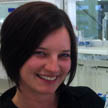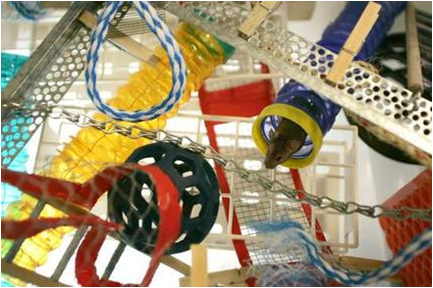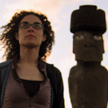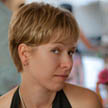
Emma Burrows
Favourite Thing: I love asking questions and finding out new things. My work allows me to do this all the time.
My CV
School:
Lindisfarne Primary School, 1989-1996, Rosebay High school, 1997-1999, Rosny College 2000-2001 (all in Tasmania)
University:
I studied neuroscience at The University of Melbourne from 2002-2005 and completed my PhD on a mouse model of schizophrenia in 2011.
Work History:
In addition to being a neuroscientist I also work at Bennettslane Jazz bar, a dark cosy institution hidden down one of Melbourne’s alleyways. I have had many jobs over the years, ranging from university lecturing to shucking abalone.
Employer:
Florey Institutes of Neuroscience and Mental Health.
Current Job:
I am a neuroscientist working with mice to understand schizophrenia and autism. I run experiments to investigate memory and social behaviour in mice, mentor students and teach neuroscience to university students.
Me and my work
I am a neuroscientist who studies mouse behaviour and brains to understand schizophrenia and autism.
When I was six, my pet mouse Maisie and I were inseparable. My grandmother sewed “Maisie” pockets on all my jumpers and tee shirts for her.
My family still find it amusing that over 20 years on, I still spend all day with mice. However these mice are a little different from Maisie.
I work at The Florey and in our laboratory we are testing how exposing mice to stimulating or enriched environments improves their memory and mood and causes changes in their brains.
We commonly use the phrase use it or lose it. Most people associate this with the physical. Exercise regularly or lose your fitness. Though, the same applies to your brain. Use your brain regularly or lose your brain. And just like you need to vary the types of exercise you do, your brain also benefits from diverse experience.
Enriched mice are housed in large cages with toys to interact with, ladders to climb, ropes to hang off, and running wheels to run in. We change their cage environment frequently, adding new toys and creating new obstacles for the mice to encounter. We also remove them from their already large cage once a day and place them in a huge chamber with many different levels, and 3D complexity. Its a bit like a mouse playground.

I work with mice that are poor learners. I test their learning and memory by using a maze that relies on a mouse’s ability to use cues around the room to remember the quickest path to the finish. Just like you would use the eureka towers to orientate yourself in southbank if you were new to Melbourne. Mice that use these cues well, get faster and faster and make less mistakes every time they have a run in the maze.
I compare mice living in enriched environments to those in non stimulating ones, without toys and in a much smaller space. While the mice living in the non stimulating environment struggle in the maze, the enriched mice perform the task, improving significantly more every day. After living in a stimulating environment, mice that are poor learners perform just as well as mice with normal learning ability. An environment with constant novelty and challenges improved their ability to learn.
What do you do to exercise your brain?
My Typical Day
There is no such thing as a typical day in my line of work.
I spend a lot of my work day with my mice. I am currently training them on a memory task that involves them selecting a correct picture on a touch-sensitive computer screen. They are rewarded for a correct choice with strawberry milkshake!
You can see a video of mice learning on a touchscreen here (if your school allows youtube videos). https://www.youtube.com/watch?v=YGtxFpicXV0

I also wear a white lab coat and isolate DNA, look down microscopes at neurons, and measure small protein molecules in brain tissue.
If I’m not hanging out with my mice or in my labcoat, I am either talking about science in meetings, writing my results up for publication in scientific journals (this is how we share our findings with people overseas) or teaching my students in the lab.
In July I flew to Barcelona in Spain to attend a conference with another 6000 neuroscientists from around the world. Conferences are a great way of making sure you know the newest findings. It’s a bonus when they are held in exotic locations.
What I'd do with the money
I would like to host a brain-art exhibition.
The brain is the most complex thing in the universe, its no wonder we struggle to understand why our brains fail to work properly sometimes.
An art curator, film maker, web designer and myself, a neuroscientist have joined forces to set up a collaboration between neuroscientists and artist. The idea is that artists will generate pieces of art inspired by the neuroscientists work. An exhibition will allow the general public to come and explore the brain-art and ask questions about the brain.
We need funding to hold this exhibition and to provide support to the artists for materials.
We hope that this exhibition will change minds, will challenge both the neuroscientists and artists and allow people to learn about the inner workings of the brain from a different angle.
My Interview
How would you describe yourself in 3 words?
The mouse whisperer
Who is your favourite singer or band?
My itunes library is sprinkled with music spanning from the 60s to now. I love to boogie with the Bee Gees, relax with Radiohead and am obsessed with discovering new local bands so I can see them in the flesh.
What is the most fun thing you've done?
Swimming with dolphins on the east coast of Tasmania. I still remember how exhilarating it was to have 2 jump over my head.
If you had 3 wishes for yourself what would they be? - be honest!
I would love to be able to teleport. I often want to be in places that are too far away to ride my bike to. To hang out with my friends in New York and the UK, to see my family in Tasmania or to escape to a beach.
What did you want to be after you left school?
I wanted to be a Marine Biologist. I have always been completely fascinated by the world that exists in the ocean. My art books were littered with sketches of plankton, I spent my school holidays snorkelling in kelp forests and I completed my high school work experience at the Marine discovery centre in Hobart.
Were you ever in trouble in at school?
Strangely, I was often in trouble in one of my science classes for asking too many questions. Now that I’m the teacher I make sure my students know that there is no such thing as a dumb question.
What's the best thing you've done as a scientist?
One of the best things I have done as a scientist is listen to mice talk. I was gob-smacked the first time I heard them! Mice communicate with each other in frequencies that are too high for us to hear and use speedy phrases of complicated chirps, harmonics and bleeps. We have specialised equipment that can transform mouse language to a form that humans can listen to. Eavesdropping in on a mouse’s conversation is truly amazing. The question still remains, what are they saying to each other?
Tell us a joke.
Two drums and a cymbal fall off a table…
Sports followed
I love running, riding my bike, sailing and epic bushwalks. However when it comes to watching sport I enjoy an AFL game or two.
Favourite team
Collingwood
My profile link:
https://organsa12.imascientist.org.au/profile/emmaburrows/






